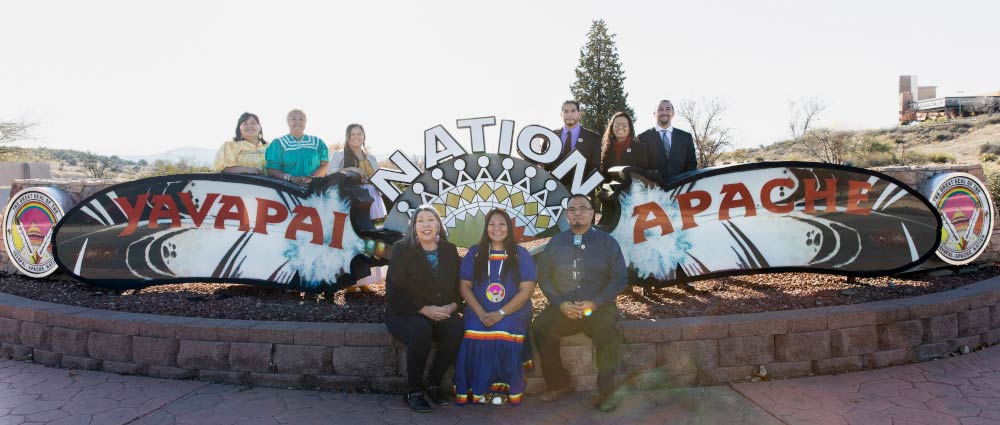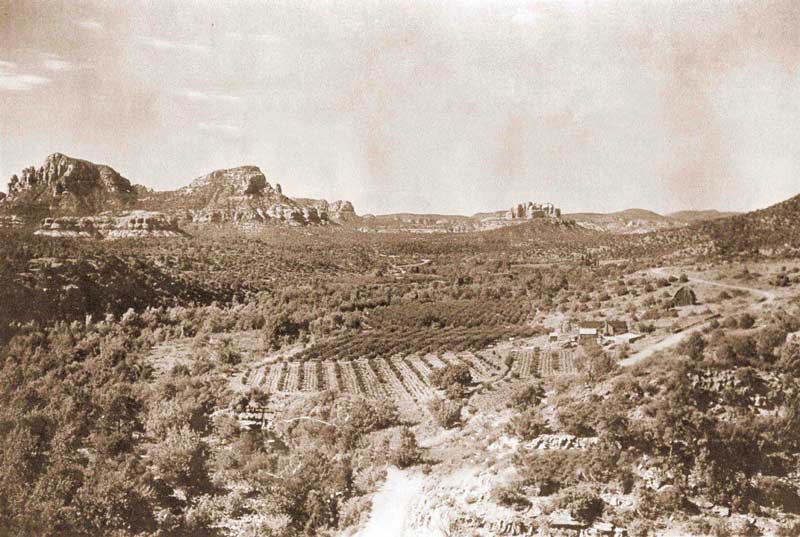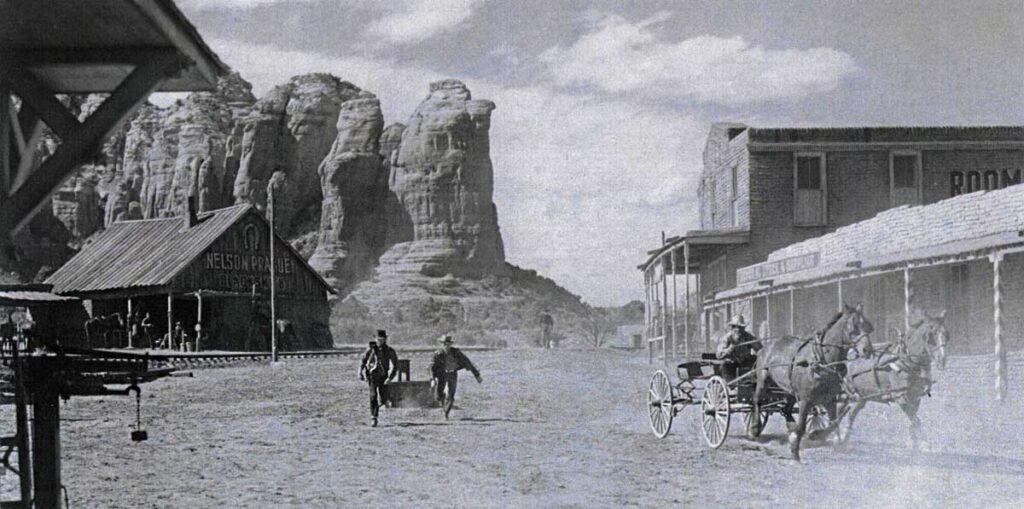A Journey Through Time
Sedona straddles the county line between Coconino and Yavapai counties in the northern Verde Valley region of the U.S. state of Arizona and is known for its stunning red sandstone formations. But there’s more to this city than meets the eye. Its rich history, unique culture, and intriguing past have shaped it into the fascinating destination it is today.
The Early Days of Sedona
Sedona’s early days are steeped in a tapestry of cultural interactions, natural splendor, and the inevitable push of frontier expansion. The region’s history is a chronicle of dates and events and a narrative of life, survival, and the enduring human spirit.
Before the first European settlers set foot in the area, Sedona’s red rock canyons and lush valleys were home to indigenous tribes, including the Sinagua, Yavapai, and Apache. These communities thrived, cultivating a deep spiritual connection with the environment and developing sophisticated knowledge systems that allowed them to flourish in the arid landscape. They built dwellings on the cliffs, farmed the rich soil, and established trade routes, creating a vibrant culture that resonates through the centuries.

In 1876, J.J. Thompson, drawn by the allure of this magnificent terrain, claimed a parcel of land under the guise of the 1862 Homestead Act, essentially taking squatters’ rights. His claim was staked across from what is now known as the Indian Gardens Store, a site tinged with the sad history of the Tonto Apaches captured by scouts from Fort Verde in present-day Camp Verde.
Thompson’s homestead set a precedent, signaling a wave of change to wash over the region. More settlers followed, each seeking their piece of the Western dream, and with them came new ways of life that clashed with the indigenous peoples’ traditions. The landscape began to change as Anglo agricultural endeavors took root, and the once-quiet wilderness buzzed with the sounds of commerce and construction.
However, this progress had a shadow side, as the arrival of settlers disrupted the established way of life for the area’s original inhabitants. The government’s policies at the time often led to the displacement of native communities, eroding their cultural heritage and connection to the land. This period was marked by tension and conflict as indigenous peoples fought to defend their land and way of life against ever-encroaching settlements.
Today, as we walk the streets of Sedona and explore its natural wonders, it’s important to remember the land’s original stewards. Their history is a story of resilience, adaptation, and a profound bond with the environment. The echoes of their presence are found in the ancient cliff dwellings, the artifacts unearthed by archaeologists, and the sacred sites they held—and continue to hold—in reverence.
Sedona’s history is a complex tapestry woven from the threads of joy and sorrow, conflict and reconciliation. As we look to the future, we carry forward the legacy of all who have called this place home, striving to honor and preserve it for generations to come.
Top 6 Websites on the History of Sedona
Visit Sedona: Provides a comprehensive overview of Sedona’s history, including early settlers and geological features.
I Love Sedona: Offers insights into historical attractions, including the Chapel of the Holy Cross and cliff dwellings.
Sedona Heritage Museum: Dedicated to preserving and teaching the history of the Sedona area.
City of Sedona: Official government site with information on historic landmarks and preservation.
Arizona Memory Project: Features collections of historic images and documents related to Sedona.
Earth Magazine: Geological insights into Sedona’s landscape and its impact on the region’s history.
The Yavapai-Apache Legacy in Sedona

Long before the squatters arrived, the area was home to the indigenous Yavapai-Apache tribe. These native communities have a deep-rooted history in the region, with their presence predating European settlers by centuries.
The Yavapai-Apache people have a rich cultural heritage deeply intertwined with the Verde Valley. They thrived in the region, cultivating a spiritual bond with the environment and developing intricate knowledge systems that allowed them to flourish amidst the rugged landscapes.
Historically, the Yavapai-Apache faced daunting challenges with the arrival of settlers, leading to displacement, conflicts, and significant changes in their way of life. However, despite these adversities, the tribe has shown remarkable resilience, preserving their traditions and continuing to play an integral role in the cultural fabric of Sedona and the greater Verde Valley.
Today, the Yavapai-Apache Nation stands as a testament to the enduring spirit of the indigenous communities of Sedona. Their contributions to the region’s history, culture, and development are invaluable. Efforts are ongoing to ensure that their legacy is preserved and celebrated, with initiatives promoting awareness, understanding, and respect for their rich heritage.

As visitors explore Sedona’s red rock formations, attend its cultural events, or delve into its history, it’s essential to recognize and honor the contributions of the Yavapai-Apache people. Their story is an integral part of Verde Valley’s tapestry, reminding us of the deep roots and diverse narratives that shape this unique region.
Pioneering Farming & Irrigation Systems
Frank Pendley, a name synonymous with ingenuity and perseverance, is a pivotal figure in the annals of Sedona’s early development. Arriving in the Verde Valley in the early 20th century, Pendley brought with him a vision that would significantly shape the region’s agricultural landscape.
However, it’s crucial to acknowledge that the innovative spirit of irrigation in the Verde Valley began with something other than Pendley or the settlers who followed. The area’s original inhabitants, the Native American tribes, had long before mastered channeling the region’s water resources to nourish their crops. Utilizing a deep understanding of the local environment, they constructed intricate irrigation networks, skillfully directing water flow from rivers and streams to their fields. These ancient systems, a testament to human ingenuity and adaptation, laid the groundwork for the agricultural practices that would follow.

Building on this legacy, Frank Pendley displayed remarkable ingenuity. Faced with the region’s arid conditions, he recognized the necessity of a reliable water source for any successful farming endeavor at Slide Rock. Drawing inspiration from the existing natural waterways, Pendley set out to engineer a system that would quench the thirsty soil of his homestead.

Through sheer determination and trial and error, Pendley developed an extensive irrigation network, a feat that ultimately led to transforming his once-barren land into a thriving orchard. His system harnessed the waters of Oak Creek, directing them across his property, where apple and pear trees soon blossomed. The fruits of his labor—quite literally—did not go unnoticed, as Pendley’s orchard bore produce that found eager markets not only in nearby Jerome and Cottonwood but as far afield as Phoenix and Los Angeles.
As we reflect on this chapter of Sedona’s history, it’s imperative to honor the contributions of both the Native Americans, who first sculpted water pathways in the Verde Valley. Their efforts showcase a timeless human trait: the ability to adapt, innovate, and thrive in even the most challenging environments.
The Birth of Sedona
In search of a life partner and a sense of community, J.J. Thompson invited his friend Abraham James and his family to relocate to Arizona, leading to the establishment of the James family’s homestead in what is now known as Sedona in 1879. This move marked the birth of Sedona, with the James family, particularly Abraham, playing a pivotal role in the area’s early development, including naming several of the region’s spectacular red-rock formations, such as Bell Rock, Steamboat Rock and Courthouse Butte.

The naming of Sedona is a tale of love and practicality. T.C. Schnebly and his wife, Sedona, were early settlers drawn to the region’s beauty. When T.C. sought to establish a post office, however, the government rejected the names he suggested, such as Schnebly Station and Oak Creek Station, for being too long for a cancellation stamp. After several rejections, T.C.’s brother proposed using “Sedona,” T.C.’s wife’s name. This suggestion was accepted, officially marking the establishment of the Sedona post office on June 26, 1902, and solidifying the community’s identity.
The Golden Age of Western Movies
In the golden era of Hollywood, when the Western genre was at its zenith, Sedona carved a niche for itself in cinematic history. Its majestic red rocks, sprawling deserts, and rugged landscapes became the backdrop for tales of cowboys, outlaws, and epic frontier adventures. From the mid-20th century onwards, Sedona’s unique topography caught the eye of filmmakers, and it was soon immortalized in celluloid, hosting almost 100 feature films and an array of video productions and commercials.
One of the earliest films shot in the region was Zane Grey’s “The Call of the Canyon.” Made in 1923, this silent film showcased the stunning vistas of Sedona, bringing its vibrant colors and dramatic scenery to audiences far and wide. However, John Wayne’s “Angel and the Badman” in 1947 truly put Sedona on the movie-making map. The film, with its classic tale of redemption and love, presented Sedona’s landscapes in a way that captivated audiences and filmmakers alike.

As Sedona’s reputation grew, a particular site became synonymous with the Westerns of the time – a custom-built movie set that epitomized the Old West. This set wasn’t just a backdrop but a character, featuring a saloon, jail, bank, and other quintessential Western structures. It hosted numerous productions and became a beloved icon, symbolizing Sedona’s contribution to the golden age of Hollywood Westerns.
However, tragedy struck in 1987 when a devastating fire razed the iconic set to the ground. The flames consumed the wooden facades, leaving behind ashes and memories. The loss of the historic set was felt deeply by the local community and those in Hollywood who had spent countless hours crafting stories within its boundaries. The site of the old western set, once teeming with actors, directors, and film crews, fell silent, marking the end of an era.
Yet, the spirit of the Old West continues to permeate Sedona. The city’s cinematic legacy is preserved through film festivals, tours, and a dedicated museum that showcases memorabilia, photographs, and stories from its illustrious past. The red rocks still echo with the sounds of galloping horses, gunfights, and dramatic showdowns from when Sedona was the frontier between reality and the silver screen.
Sedona and the Digital Age
By the 21st century, Sedona had evolved into a thriving city known for its stunning landscapes, rich history, and vibrant culture. The city’s official website, www.sedonaaz.gov, serves as a hub of information for residents and visitors, providing access to community news, government services, and local events.
Social media platforms have also been central to this evolution. Sedona’s stunning landscapes, cultural happenings, and distinctive local businesses are frequently featured on networks like Instagram, Facebook, and Twitter. These platforms accentuate the city’s natural allure and dynamic arts community and establish an interactive forum for dialogue. People from Sedona and worldwide share their experiences, images, and narratives, cultivating a worldwide community united by a shared affection for the city.
In addition to social media, Sedona’s enterprises, particularly in the tourism and hospitality industries, have utilized modern platforms to engage broader audiences. Activities ranging from virtual art gallery tours and online reservations for local excursions to electronic menus for restaurant curbside pickups showcase the city’s innovative spirit. These initiatives have been essential in sustaining the city’s economic vitality, especially during global crises like the COVID-19 pandemic.

Sedona’s environmental and cultural projects have also found a broader stage. Campaigns focusing on sustainability, wildlife conservation, and the reduction of light pollution have global reach, promoting awareness and involvement in these vital endeavors. Local environmental groups and spiritual retreats host online events, workshops, and live streams, promoting broader engagement and disseminating Sedona’s principles of environmental care and spiritual health.
Moreover, local news sources and community blogs have transitioned online, offering immediate news and details on various topics, from municipal decisions to forthcoming celebrations. This access ensures residents remain informed and engaged in local governance and communal events, strengthening the robust community bonds that define Sedona.
Educational programs have similarly reaped the benefits of these advancements. Schools and libraries in the area provide online materials, classes, and digital books, promoting accessible learning for all age groups. Efforts are underway to digitize historical archives, including those that chronicle Sedona’s rich Native American legacy and pioneering past, preserving these cultural moments for future generations.
Through its measured embrace of these contemporary methods, Sedona maintains a delicate balance between progress and its storied past and the conservation of its natural vistas, affirming its status as a lively, flourishing community that remains profoundly tied to its heritage and principles while extending a hand to the broader world.
Sedona’s Geology
Sedona’s geology is a marvel, with its iconic red rock formations drawing visitors worldwide. These natural structures owe their existence and unique appearance to the Schnebly Hill Formation, a specific stratum of rock in the Sedona area. This formation is part of the larger Supai Group that extends across the Colorado Plateau, which includes parts of Arizona, Utah, Colorado, and New Mexico. However, the specific characteristics and appearance of the Schnebly Hill Formation, as seen in Sedona, are unique due to local environmental conditions and the area’s geological history.
The formation comprises a substantial layer of sandstone that varies in color from deep red to bright orange, creating the vibrant landscapes that have become synonymous with Sedona. The distinct hues and patterns seen in these rocks are a result of the iron oxide and the various environmental forces that have shaped them over millions of years, adding to Sedona’s natural allure and its status as a geological wonder.

The origins of the Schnebly Hill Formation trace back to the Permian Period, approximately 250 to 300 million years ago. During this prehistoric era, the region that is now Sedona was situated close to the equator and was a low-lying basin with a climate and conditions similar to present-day coastal plains near the equator. Rivers and streams carried down sediments from the surrounding highlands into this basin, where they settled and gradually compacted into the layers of sandstone visible today.
Over millions of years, the forces of nature, including the shifting of tectonic plates and the relentless work of wind and water, sculpted these sandstone layers into the breathtaking formations we see today. The iron oxide present in the rock layers is responsible for the striking red and orange hues that are most vibrant at sunrise and sunset. These colors are not just superficial; they penetrate the rock due to the oxidation of iron minerals within the sandstone, much like the process of rusting.
In addition to the Schnebly Hill Formation, Sedona’s geology features several other formations, each with its unique characteristics and each contributing to the area’s stunning geological diversity. These include the Coconino Sandstone, known for its pale yellow color and cross-bedded layers indicative of wind-blown sand dunes, and the Hermit Formation, which contains evidence of ancient soils and varied sedimentary structures pointing to a history of fluctuating climate conditions.
Sedona’s geological formations are more than just beautiful scenery; they are windows into the ancient past, providing invaluable opportunities for scientific study. Geologists and paleontologists have gleaned insights into Earth’s history through these rocks, uncovering fossils and geological features that tell stories of ancient environments and the life forms that once inhabited them.
The red rocks of Sedona are a source of natural beauty and tourism and a continuous source of knowledge and wonder, inspiring questions about our planet’s fascinating history and the dynamic processes that have shaped it over billions of years.
The Climate of Sedona
Sedona, Arizona, is known for its temperate semi-arid climate, which is characterized by mild winters and warm summers. This climate is a defining feature of the city and plays a crucial role in shaping its unique ecosystem, supporting a diverse range of flora and fauna.
Temperature and Precipitation:
- Sedona experiences mild temperatures throughout the year, with an average high in the warmest month (July) around 97°F (36°C) and an average low in the coldest month (December) near 31°F (-0.5°C).
- The city receives a moderate amount of precipitation annually, averaging about 18.66 inches. The majority of the rainfall occurs during the monsoon season from July to September, contributing to the area’s lush vegetation despite its semi-arid classification.
Flora and Fauna:
- The climate supports a rich biodiversity. The area’s vegetation includes various types of cacti, juniper trees, and other desert flora, as well as riparian species along Oak Creek.
- Wildlife in the area includes mammals such as coyotes, javelinas, and mule deer; birds like the peregrine falcon and red-tailed hawk; and various reptiles.
Impact on Tourism:
- The mild climate is one of the factors that make Sedona a popular tourist destination, especially for outdoor activities like hiking, biking, and bird-watching, among others.
Environmental Concerns:
- However, like many regions, Sedona faces environmental challenges. Issues such as drought, potential water scarcity, and the risk of wildfires are concerns due to climate change. These factors not only threaten the local ecosystem but also have implications for tourism and the community’s way of life.
Sedona’s Demographics
Sedona’s demographic landscape has evolved over the years, reflecting a rich tapestry of cultural, social, and economic diversity. As of the 2020 Census, the city’s population stood at 9,684, a slight decrease from the 10,031 residents recorded in the 2010 Census. This population encompasses a wide spectrum of individuals, from retirees seeking the serene landscapes of Sedona for their golden years, to artists drawn by the city’s natural beauty and inspirational landscapes and entrepreneurs attracted by the burgeoning opportunities the city presents.
The demographic composition is also notable for its diversity. The population includes a significant proportion of individuals aged 65 and over, representing 36.3% of the residents, indicative of the city’s appeal to retirees. The female population marginally outnumbers the male, with women constituting 52.1% of the populace.
Ethnically, Sedona is predominantly White (78.4%), with Hispanic or Latino individuals accounting for 20.5% of the population. Other ethnic groups, including Black or African American, American Indian and Alaska Native, Asian, and those identifying with two or more races, make up the remainder, contributing to the city’s multicultural ambiance.
The city’s educational profile is impressive, with 49.0% of persons aged 25 years and over holding a bachelor’s degree or higher, and 92.4% having at least a high school diploma. This emphasis on education is a driving force for the community’s continued growth and prosperity.
Economically, Sedona presents a vibrant scene, with a median household income of $58,901. The workforce is actively engaged in various sectors, with notable contributions in accommodation and food services, retail trade, and health care and social assistance. However, there’s a segment of the population, 11.3%, that still lives below the poverty line, an issue that calls for continued social and economic development strategies.
The city’s housing market is robust, with a median value of owner-occupied housing units at $569,800, reflecting the area’s desirability. However, this also points to the need for diverse housing solutions to accommodate various income levels.
Sedona’s demographic journey tells a story of growth, diversity, and potential. As the city continues to evolve, it faces the challenge of balancing development with the preservation of its unique cultural and natural heritage, a task that requires the collective effort of all its residents.
Sedona’s Cultural Scene
Sedona, Arizona, is a haven of natural beauty and a vibrant center for the arts. This small town is a big scene for artists and art collectors alike, with at least 30 galleries featuring an array of work from both world-renowned and emerging artists. These galleries are scattered throughout the town, with a significant concentration along State Route 179, known as Gallery Row.
The city’s art scene is as diverse as its landscape. It offers everything from fine art paintings and abstracts to Western bronzes, kinetic sculptures, contemporary jewelry, Native American crafts, large-format photography, ceramics, and much more. This diversity continues a long-standing tradition, with Sedona having been home to notable artists like surrealist Max Ernst and a founding location for organizations like the Cowboy Artists of America.
Sedona’s cultural vibrancy continues beyond visual arts. The city hosts numerous events, including a monthly 1st Friday Evening in the Galleries, where art enthusiasts can enjoy openings, demonstrations, and receptions. The Sedona International Film Festival & Workshop, Chamber Music Sedona, and the Sedona Arts Center are just a few of the institutions that contribute to the city’s rich cultural tapestry, offering a range of performances, screenings, and educational opportunities.
This thriving arts scene is integral to Sedona’s identity and appeal, drawing visitors and artists from around the globe and solidifying its reputation as a cultural hub nearly on par with cities like Santa Fe. Sedona’s art and culture scene will surely inspire you whether you’re an art collector, artist, or enthusiast.
In Conclusion
Sedona’s history is as colorful and diverse as its stunning red rock landscapes. From its early days as a settlement for indigenous people to its current status as a thriving city known for its natural beauty and vibrant culture, Sedona has a rich and unique history that continues to shape its identity today.

